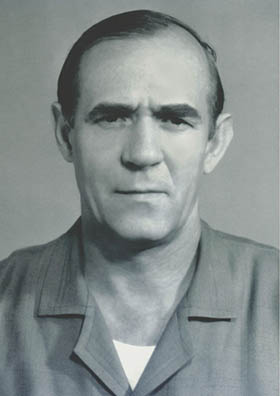History of Zaporozhye region
Milestones of the history of the native land
The history of the Zaporozhye region is amazing and diverse. It originates from the time of the Middle Paleolithic (more than 40 thousand years ago). Cimmerians, Scythians, Sarmatians, Polovtsiennes, Slavs of Kievan Rus and, of course, Zaporozhye Cossacks - all those are landmarks of the history of the Zaporozhye region.
The Zaporozhye region is rich, not only by the diversity of its peoples, but also by historic events of great importance to the entire Northern Black Sea region. The battle on the Kalka River, the death of Prince Svyatoslav, the creation and the fall of the Zaporozhian Sichi are the stories, without which the land of the Zaporozhye is impossible to imagine.
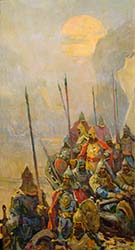
In the long march
Oil on cardboard
1980-1983
21 x 39 in.
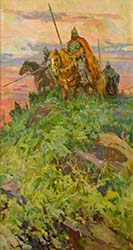
On patrol
Oil on cardboard
1980-1983
21 x 39 in.
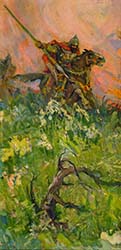
The fearless fight
Oil on cardboard
1980-1983
21 x 39 in.
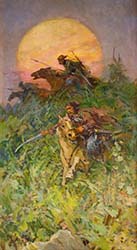
Night attack
Oil on cardboard
1980-1983
21 x 39 in.
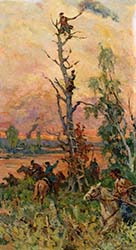
Alert
Oil on cardboard
1980-1983
21 x 39 in.
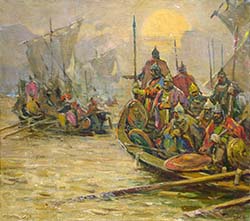
In the lower reaches of
the Slavutych river (Dnieper)
Oil on canvas
1980-1983
15 x 15 in.
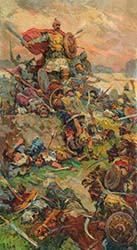
The last battle of
Prince Svyatoslav
Oil on cardboard
1980-1983
21 x 39 in.
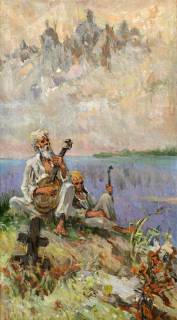
Songs of Kobzar about the
heroes of the homeland
Oil on canvas
1980-1983
31 x 17 in.
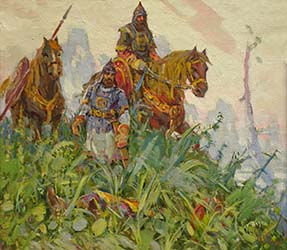
Fallen comrade-in-arms
Oil on canvas
1980-1983
17 x 17 in.
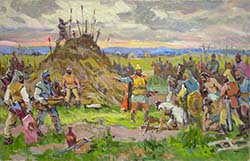
Khazar prisoners
Sketch
Oil on canvas
The 1980s
21 x 39 in.
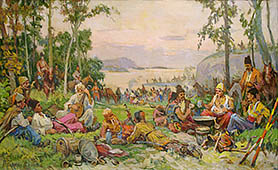
In Zaporozhye Sech
Oil on canvas
1979
21 x 35 in.
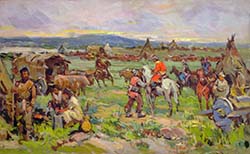
Scythian camp on theshore of Borisphen (Dnieper)
Sketch
Oil on canvas
The 1980s
21 x 39 in.
The Amazons are war girls
The history of Amazons is rooted in ancient Greek mythology. According to the ancient myth of the Amazons, this is a nation composed exclusively of woman who formed their own state. They were brutal and aggressive, and their main purpose in life was war. To reproduce the offspring the Amazons were in contact with men. They kept men as sex slaves or mated with people from neighboring tribes. They killed their male children, or sent them to live with their foreign fathers. They only left the girls born alive and then raised the new Amazons. In order to be unimpeded in war, the Amazons burned off their right breasts by red-hot a bronze instrument constructed for this purpose so they wouldn't interfere with the use of the bow.
The history of Zaporozhye region has its own legends about Amazons. These legends tell stories about some of the Scythian rites of initiation of girls into warriors. It was difficult to say whether the decision of girls to become a warrior was volunteered, on what principle was the selection of girls, and at what age. But the fate of those girls-warriors was unenviable. During the battle with the enemy, Amazons cavalry was the first to fight. The task of the cavalry was to put confusion into the enemy line. It was unknown whether this task was achieved by military mastery of girls or only appearance of the horsewomen-warriors stunned the enemy, but the chaos effect in the enemy army has been achieved. Following the Amazons, the main combat troops were marching on the shocked enemy. Previously, there was no convincing evidence for the existence of Amazons. But the archaeological finds of the 1950s in the Ukraine changed the view of historians about the existence of female warriors.
Numerous barrows in the south of Ukraine are Scythian-Sarmatian "military graves". About 20% of these graves contained the remains of women dressed in men's suits for battle. Next to them were swords, daggers, bows and arrows. Under Melitopol there is one of the main attractions of the Zaporozhye region - Stone Tomb. Many rock paintings and inscriptions of ancient people were found in the grottoes and caves of the Stone Tomb. Looking at some of them, we can assume that the ancient rites of initiation of girls in warrior took place in those grottoes.
Those rites are depicted in the painting of P. Redin "Ritual of initiation of girls into warriors" and in his diorama “The Amazons on the Stone Grave".
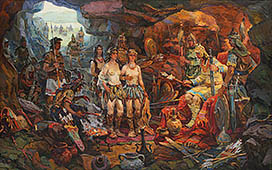
Dedication of girls into warriors
Oil on canvas
1983
29 х 47 in.
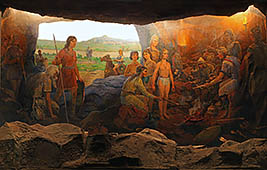
Amazons on a stone grave. Diorama
(authors: P.Redin, Y. Smirnov)
Melitopol City History Museum.
Length 10 ft, height 6 ft.
Prince Svyatoslav Igorevich
Svyatoslav Igorevich, (died 972), was grand prince of Kiev from 945, the greatest of the Varangian princes of early Russo-Ukrainian history, one of the creators of the Russian state (first the Russian empire). He was one of the most outstanding rulers and generals of Russia, a brave warrior, and a competent politician.
The tragic milestone in the fate of the Great Russian prince is connected with the Zaporozhye region. According to the official version in the spring of 972 Svyatoslav with a small retinue returned to Kievan Rus after the war with Byzantium. When he tried to cross the cataracts near Khortitsa Island he was ambushed and killed in an unequal battle with the Pechenegs (a Turkic people). The remaining members of the squad buried Svyatoslav on Khortitsa Island.
The personality of Svyatoslav was reflected in the works of P. Redin. A funeral of the Grand Duke recreated on the canvas "The funeral of Prince Svyatoslav on Saint Gregory Island/ Khortitsa Island.
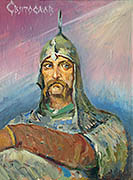
Svyatoslav, Grand Prince of Kiev
Oil on canvas
1980-1983
31 x 23 in.
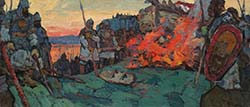
Funeral of Prince Svyatoslav Igorevich
near the Dnieper rapids in 972
Sketch
Oil on canvas
The 1980s
19 x 45 in.
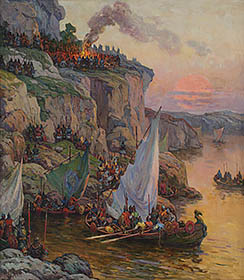
The funeral of Prince Svyatoslav on the
St. Gregory island /Khortytsya island/
Oil on canvas
1981
45 x 39 in.
Zaporozhian Sich
Zaporozhian Sich was the military and political organization of the Cossacks in the 16th to 18th centuries centred in the region around today's Kakhovka Reservoir and spanning the lower Dnieper River in Ukraine.
The Zaporozhian Sich emerged as a method of defense by Slavic colonists against the frequent and devastating raids of Crimean Tatars, who captured and enslaved hundreds of thousands of Ukrainians, Belorusians and Poles. The Ukrainians created a self-defence force, named the Cossacks. They built fortified camps (siches) that were later united to form a central fortress, the Zaporozhian Sich. Cossacks made many victorious campaigns and won many hard battles.
During the course of the 16th, 17th and well into the 18th century, the Zaporozhian Cossacks became a strong political and military force that challenged the authority of the Tsardom of Russia. By order of the tsarist government on May 14 (25), 1709, the Zaporozhian Sich was destroyed by the troops of Colonel Yakovlev. And finally, the fate of the Zaporozhian Cossacks was decided on August 5, 1775, when the Russian Empress Catherine II signed the manifesto on the destruction of the Zaporozhian Sich.
Legends about the Zaporozhian Cossacks, and about the fall of the Zaporozhian Sich have reached our days. Some of those stories P. Redin heard from the local old-timers. Perhaps that is why in his picture “The Destruction of Zaporozhian Sich by the Soldiers of Catherine II” he was able to recreate the tragedy of that long-standing event.
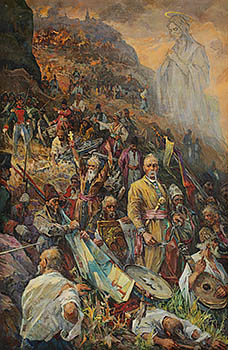
The destruction of Zaporozhye Sech by soldiers of Catherine II in 1775
(the last ataman of Zaporozhian Army Petro Kalnyshevsky)
Oil on canvas
1987
59 x 39 in.
Alexander Pushkin on the banks of the Dnieper River
Alexander Pushkin was a Russian poet, playwright, and novelist of the Romantic era, who is considered by many to be the greatest Russian poet and the founder of modern Russian literature.
In May 1820 Pushkin traveled from Petersburg to the Caucasus and to the Crimea. On the way to the Caucasus, he drove along the right bank of the Dnieper to the Kichkas ferry (located near the present Dnieper hydroelectric dam). There Pushkin crossed to the left bank of river and stopped for one night in Aleksandrovsk (now Zaporozhye).
The events associated with the short stay of Alexander Pushkin on the banks of the Dnieper depicted on the paintings of P. Redin.
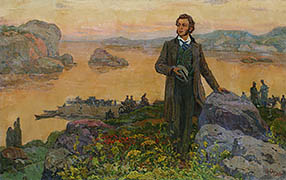
Alexander Pushkin near Kichkas crossing
of the river Dnieper. May 1820
Oil on canvas
1983
29 x 47 in.
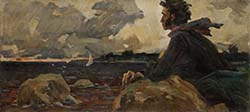
Alexander Pushkin on the bank of the Dnieper
Oil on canvas
1971
19 x 45 in.
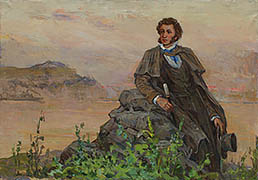
Alexander Pushkin in Alexandrovsk
Oil on canvas
1981
23 x 35 in.
Taras Shevchenko in Zaporozhye
Taras Shevchenko was a Ukrainian poet, writer, artist, public and political figure, as well as folklorist and ethnographer. His literary heritage is regarded to be the foundation of modern Ukrainian literature and, to a large extent, the modern Ukrainian language. Shevchenko is also known for many masterpieces as a painter and an illustrator. In the summer of 1843 he visited Zaporozhye (in the region beyond the Dnieper rapids). The Dnieper rapids, the endless southern steppes, the Great Meadow left unforgettable impressions in the poet's soul. Most of all Taras Shevchenko liked the Khortytsya Island- the cradle of Zaporozhian Cossacks, the magical keeper of the spirit of Zaporozhian Sich.
Old-timers who lived in Zaporozhye in 1950-70 heard from their grandfathers many stories about Shevchenko's stay in the Zaporozhye region. Those stories helped P. Redin recreate the image of the poet on his canvases.
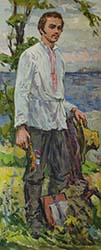
Youth of Taras Shevchenko
Oil on canvas
1977
31 x 13 in.
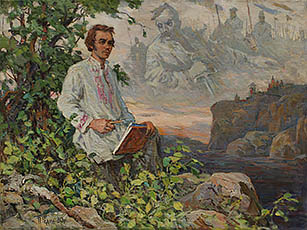
Tаras Shevchenko visited Khortytsa island in 1843
Oil on canvas
1980
25 x 25 in.
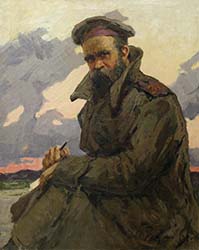
Portrait of Taras Shevchenko
(in the Peter fortress)
Oil on canvas
1973
32 x 41 in.
This painting is in the collection of Melitopol
City Historical Museum
Novoaleksandrovsk settlement
The painting of P. Redin and A.Fomin "Novoaleksandrovsk settlement" is a large historical canvas (size 78 x 118 in.), which is exhibited in historical Museum of Melitopol city. The painting depicts a small settlement in the southern Ukrainian steppes. This settlement is notable for the fact that the large cultural and industrial center of Ukraine, the city of Melitopol, took its origin from it..
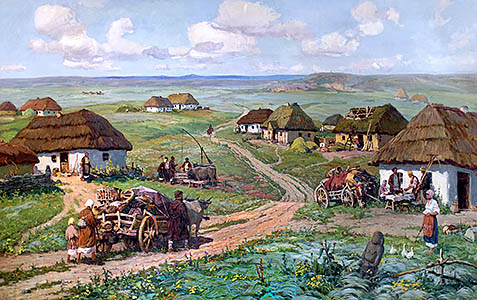
Novoaleksandrovsk settlement (authors: P.Redin, A.Fomin)
Oil on canvas
1972
78 x 118 in.
This painting is in the collection of Melitopol City Historical Museum.
Old Aleksandrovsk
The city Alexandrovsk bore its name after the name of the Alexandrovsk Fortress which was erected in 1770 for protection of the southern territories of Russian Empire from Crimean Tatar invasions. In 1921 the city name was changed to Zaporozhye. Zaporozhye is hometown of P. Redin. The artist loved and knew his city well. At the time of writing many of his canvases for documentary recreation of the views of the old city, he personally consulted with the contemporaries of the old Aleksandrovsk, local historians and ordinary citizens of Zaporozhye. Two of P.Redin works dedicated to his native city are in the collection of the Zaporozhye Regional Lore Museum.
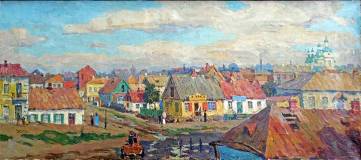
Outskirts of Aleksandrovsk
Oil on canvas
1958
19 x 45 in.
This painting is in the collection of
Zaporozhye Regional Lore Museum
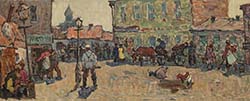
Old Alexandrovsk
Sketch
Oil on canvas
1950
19 x 45 in.
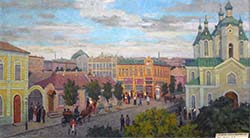
Old Alexandrovsk
Oil on canvas
1958
19 x 35 in.
This painting is in the collection of
Zaporozhye Regional Lore Museum
